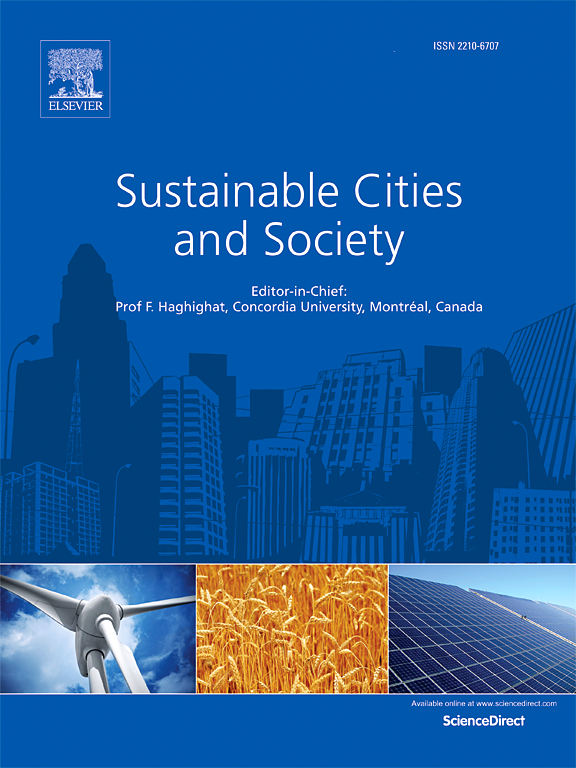Assessing annual carbon emissions and its peak year in the Yangtze river economic belt (2021-2035) through land use/land cover analysis
IF 10.5
1区 工程技术
Q1 CONSTRUCTION & BUILDING TECHNOLOGY
引用次数: 0
Abstract
As a major carbon emitting country, China is committed to peak carbon emissions before 2030. The Yangtze River Economic Belt (YREB), a key economic region in China, plays a significant role in national carbon emissions, making it crucial to study its emissions. This study uses the STIRPAT model and the Grey Model (GM) to analyze the carbon emissions of building land from 2021 to 2035; then the Patch-generating Land Use Simulation model (PLUS) is employed to predict the land-use changes over next 15 years, and future emissions from cropland, forest, grassland, water area, and unused land estimated using emission coefficients. Finally, carbon emissions across the YREB are calculated and mapped. The projections reveal that carbon emissions from building land increase and then decrease in the baseline scenario from 2021 to 2035. However, carbon emissions from cropland decline annually. Furthermore, this study identifies 2028 as carbon peak year in YREB area, totaling 8.278 × 108t. Additionally, diminishing total energy consumption and the proportion of some industries may be beneficial for regional carbon reduction. The results of this study are instructive for carbon emission reduction and peak carbon attainment in China.
基于土地利用/土地覆盖分析的长江经济带年碳排放及其峰值年份(2021-2035
作为碳排放大国,中国致力于在2030年前实现碳排放峰值。长江经济带是中国重要的经济区域,在全国碳排放中占有重要地位,对其碳排放进行研究至关重要。本文采用STIRPAT模型和灰色模型(GM)对2021 - 2035年中国建筑用地碳排放进行了分析;利用斑块生成土地利用模拟模型(PLUS)预测了未来15年的土地利用变化,并利用排放系数估算了未来农田、森林、草地、水域和未利用地的排放。最后,对整个长江经济带的碳排放量进行了计算和绘制。预测显示,在2021年至2035年的基线情景中,建筑用地的碳排放量先增加后减少。然而,农田的碳排放量每年都在下降。2028年为YREB地区碳峰值年,总量为8.278 × 108t。此外,减少总能源消耗和某些行业的比例可能有利于区域碳减排。研究结果对中国碳减排和碳峰值的实现具有一定的指导意义。
本文章由计算机程序翻译,如有差异,请以英文原文为准。
求助全文
约1分钟内获得全文
求助全文
来源期刊

Sustainable Cities and Society
Social Sciences-Geography, Planning and Development
CiteScore
22.00
自引率
13.70%
发文量
810
审稿时长
27 days
期刊介绍:
Sustainable Cities and Society (SCS) is an international journal that focuses on fundamental and applied research to promote environmentally sustainable and socially resilient cities. The journal welcomes cross-cutting, multi-disciplinary research in various areas, including:
1. Smart cities and resilient environments;
2. Alternative/clean energy sources, energy distribution, distributed energy generation, and energy demand reduction/management;
3. Monitoring and improving air quality in built environment and cities (e.g., healthy built environment and air quality management);
4. Energy efficient, low/zero carbon, and green buildings/communities;
5. Climate change mitigation and adaptation in urban environments;
6. Green infrastructure and BMPs;
7. Environmental Footprint accounting and management;
8. Urban agriculture and forestry;
9. ICT, smart grid and intelligent infrastructure;
10. Urban design/planning, regulations, legislation, certification, economics, and policy;
11. Social aspects, impacts and resiliency of cities;
12. Behavior monitoring, analysis and change within urban communities;
13. Health monitoring and improvement;
14. Nexus issues related to sustainable cities and societies;
15. Smart city governance;
16. Decision Support Systems for trade-off and uncertainty analysis for improved management of cities and society;
17. Big data, machine learning, and artificial intelligence applications and case studies;
18. Critical infrastructure protection, including security, privacy, forensics, and reliability issues of cyber-physical systems.
19. Water footprint reduction and urban water distribution, harvesting, treatment, reuse and management;
20. Waste reduction and recycling;
21. Wastewater collection, treatment and recycling;
22. Smart, clean and healthy transportation systems and infrastructure;
 求助内容:
求助内容: 应助结果提醒方式:
应助结果提醒方式:


